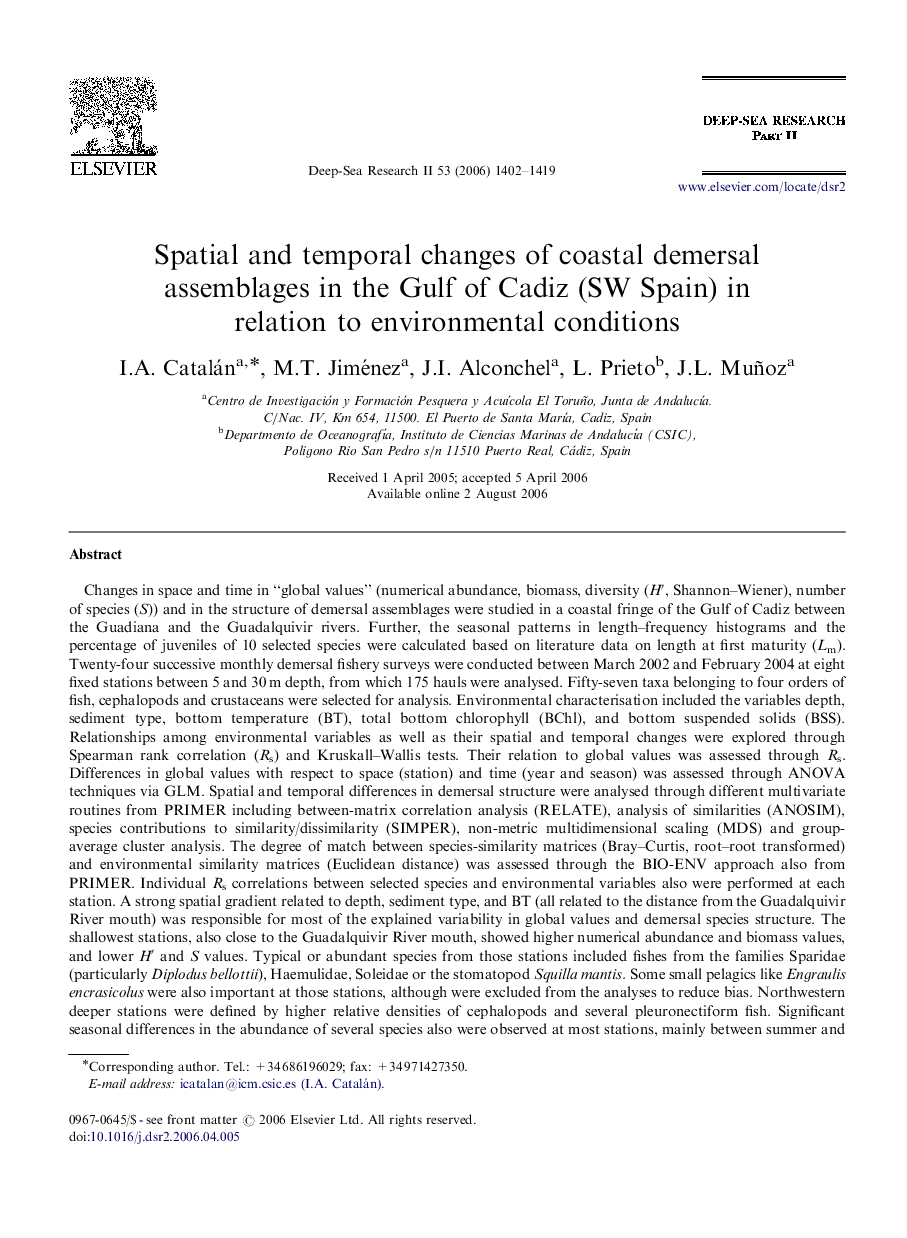| کد مقاله | کد نشریه | سال انتشار | مقاله انگلیسی | نسخه تمام متن |
|---|---|---|---|---|
| 4538302 | 1626515 | 2006 | 18 صفحه PDF | دانلود رایگان |

Changes in space and time in “global values” (numerical abundance, biomass, diversity (H′, Shannon–Wiener), number of species (S)) and in the structure of demersal assemblages were studied in a coastal fringe of the Gulf of Cadiz between the Guadiana and the Guadalquivir rivers. Further, the seasonal patterns in length–frequency histograms and the percentage of juveniles of 10 selected species were calculated based on literature data on length at first maturity (Lm). Twenty-four successive monthly demersal fishery surveys were conducted between March 2002 and February 2004 at eight fixed stations between 5 and 30 m depth, from which 175 hauls were analysed. Fifty-seven taxa belonging to four orders of fish, cephalopods and crustaceans were selected for analysis. Environmental characterisation included the variables depth, sediment type, bottom temperature (BT), total bottom chlorophyll (BChl), and bottom suspended solids (BSS). Relationships among environmental variables as well as their spatial and temporal changes were explored through Spearman rank correlation (Rs) and Kruskall–Wallis tests. Their relation to global values was assessed through Rs. Differences in global values with respect to space (station) and time (year and season) was assessed through ANOVA techniques via GLM. Spatial and temporal differences in demersal structure were analysed through different multivariate routines from PRIMER including between-matrix correlation analysis (RELATE), analysis of similarities (ANOSIM), species contributions to similarity/dissimilarity (SIMPER), non-metric multidimensional scaling (MDS) and group-average cluster analysis. The degree of match between species-similarity matrices (Bray–Curtis, root–root transformed) and environmental similarity matrices (Euclidean distance) was assessed through the BIO-ENV approach also from PRIMER. Individual Rs correlations between selected species and environmental variables also were performed at each station. A strong spatial gradient related to depth, sediment type, and BT (all related to the distance from the Guadalquivir River mouth) was responsible for most of the explained variability in global values and demersal species structure. The shallowest stations, also close to the Guadalquivir River mouth, showed higher numerical abundance and biomass values, and lower H′ and S values. Typical or abundant species from those stations included fishes from the families Sparidae (particularly Diplodus bellottii), Haemulidae, Soleidae or the stomatopod Squilla mantis. Some small pelagics like Engraulis encrasicolus were also important at those stations, although were excluded from the analyses to reduce bias. Northwestern deeper stations were defined by higher relative densities of cephalopods and several pleuronectiform fish. Significant seasonal differences in the abundance of several species also were observed at most stations, mainly between summer and winter. Species like Merluccius merluccius were particularly abundant in winter, whereas Arnoglossus laterna was more abundant in summer. Length–frequency analyses showed that changes in abundance were, in many cases, related to the massive appearance of small individuals in the area. Juvenile stages were observed either exclusively or temporally for many of the analysed taxa, revealing the high importance of this zone as a nursery.
Journal: Deep Sea Research Part II: Topical Studies in Oceanography - Volume 53, Issues 11–13, June 2006, Pages 1402–1419